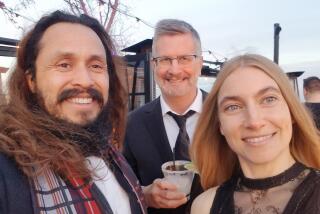Lack of physical proof didn’t deter jury
A day after a Pasadena jury convicted Michael Goodwin of murder in the deaths of racing legend Mickey Thompson and his wife, jurors said they had no problem reaching guilty verdicts, despite a lack of physical evidence tying the defendant to the murder scene.
“There was never anybody that said, ‘No way, there’s no way,’ ” said Mark Matthews, 52, the jury foreman. “We never had to convince anybody that he was guilty. We only had to make sure we were following the law correctly.”
The Thompsons were gunned down in the driveway of their home in the eastern Los Angeles County community of Bradbury on March 16, 1988, by two hooded gunmen who escaped on bicycles. The killers were never identified; Goodwin was charged with planning the murders.
With many mysteries still surrounding the case, observers had wondered if the jury would be able to reach unanimous verdicts so long after the crime.
“I could not have ever believed that 12 people would consider this proof beyond a reasonable doubt, and I continue to be stunned,” Deputy Public Defender Elena M. Saris said.
But jurors said the judge’s instructions clarified how they viewed evidence during six days of deliberation. For example, jurors said that before joining the trial many of them did not know that circumstantial and direct evidence could be weighed equally in making their decision.
“All our understanding of the legal system [was] based on television shows,” Matthews said. “People think that every single fact has to be proven and DNA-ed and stamped, that it has to be an open-and-shut, gun-in-hand and blood-on-the-T-shirt kind of case, which this obviously wasn’t.”
Only one previous ballot was taken the day before Goodwin’s conviction, and that resulted in a single not-guilty vote and two undecided votes. However, after rereading the jury instructions and discussing the evidence, jurors said, the three voted with the majority.
The murders of Mickey and Trudy Thompson fascinated the media and were the subject of “America’s Most Wanted” and other television shows. Saris argued that the time between the crime and the trial, along with the “Hollywood treatment” of the case, had hopelessly tainted the memories of witnesses, some of whom did not come forward for years. “They have no killers, no plan, no meeting, no weapon, no phone calls, no payout, no nothing,” she said.
The prosecution presented testimony from a dozen witnesses that Goodwin had threatened to kill his former racing-promoter partner, as well as evidence that Goodwin had nearly been bankrupted by a $514,000 court judgment in Thompson’s favor.
Jurors said they methodically sifted through evidence and believed that there was a preponderance that pointed to Goodwin’s guilt.
“There were so many reasons in everyone’s mind that it would be a logical, reasonable deduction to say, ‘Who else?’ ” Matthews said. “You know what I mean? Who else?”
Juror Bob Briggs, 69, said it was the “collective weight” of the evidence, not a single piece, that determined the case.
“We didn’t have to connect Michael Goodwin to the murderers,” Matthews said. “We just had to believe that he planned the murders, that he aided and abetted them. We didn’t have to have the smoking gun.”
Goodwin, 61, will be sentenced to life in prison without parole. The defendant, who has been in jail for the last five years without bail, hung his head Thursday when the verdicts were read and said “I didn’t do it” twice, according to Saris.
Saris said she would ask Los Angeles County Superior Court Judge Teri Schwartz for a new trial and, if that fails, Goodwin would appeal to a higher court. Goodwin was “tremendously disappointed and incredibly frustrated” by the verdicts but has faith the truth will come out, Saris said.
Laurie Levenson, a professor of criminal law at Loyola Law School, said judgments based on circumstantial evidence are often the norm in murder cases. “The evidence is still not proof beyond all doubt, it’s just proof beyond a reasonable doubt. You don’t have to dot all the I’s or cross all the Ts, or have ‘CSI’ evidence to win a murder conviction.”
The trial and deliberations left the four-man, eight-woman jury emotionally frayed and mentally exhausted. Two jurors cried as the verdicts were read.
“It’s the hardest decision I’ve made in my life, and hopefully the hardest decision I will have to make,” said one of the jurors who cried. She identified herself as Trudy, 50, but declined to give her last name.
Briggs also said it was important to remember that jurors are not allowed to discuss the case or view media reports on it while it is pending.
“All we can go on is the testimony that comes out of that box by people who are under oath,” he said. “So all this other stuff that people want to bring up, as to why you didn’t think about this or that, we don’t know about that and it’s designed that way. So all I can say is, ‘Excuse me, all I know is what I was told I could use and it’s just that simple.’ Hopefully you would have come to the same conclusion we did.”
More to Read
Sign up for Essential California
The most important California stories and recommendations in your inbox every morning.
You may occasionally receive promotional content from the Los Angeles Times.










